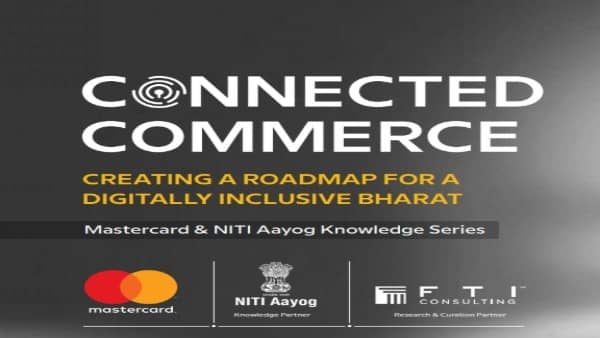
DIGITALLY INCLUSIVE BHARAT
CONTEXT
The NITI Aayog and Mastercard have released a report titled ‘Connected Commerce: Creating a Roadmap for a Digitally Inclusive Bharat’.
MORE ABOUT NEWS
CHALLENGES TO DIGITAL FINANCIAL INCLUSION’ (DFI)
Gap on the demand side – efforts on the supply side of DFI have seen manifestations either in egovernance,
the JAM trinity or GST systems
o In the current system, most bank or digital accounts can be credited through government’s DBT schemes, or transfers from employers, or through peer-to-peer transfers.
o However, the break in the digital financial flow comes at the last mile where account holders have to withdraw cash or write physical checks for their end use.
NBFC Issues – NBFCs currently account for 20-30% of the overall credit given in the system.
o NBFCs are practically constrained from the credit card market on account of high access barriers, especially regarding the issuance of general credit cards. They are barred from issuing variants of other cards, like charge cards, debit cards, and stored value cards.
Security issues and trust on system – As we get more digitally integrated, we must evaluate the strength and resilience of digital payments to not just protect consumers from frauds, but to also maintain trust in financial services.
o As new users join digital payment systems, they need a good experience, to continue using these avenues. Any failures will result in setbacks. When users lose confidence in digital payments, they build backups (cash in hand), or move back to cash.
MSMEs inability to access formal finance – MSMEs have been a key growth driver for the Indian economy
o Banks limit their loan exposure to MSMEs, because they have a higher perceived risk of non-performance, limited available performance or credit data, and low ability to provide security collateral.
Digitally Accessible Transit Systems – With the onset of the pandemic, there is an increasing need for transit systems to be further integrated with contactless payments in India.
o Globally, the trend is toward open-loop transit systems, with interoperable payment solutions allowing travelers to switch between different modes of transport with a connected payments network.
RECOMMENDATIONS
Accelerating the Next Phase of Digital Financial Inclusion
DIGITAL FINANCIAL INCLUSION’ (DFI)
Digital financial inclusion’ (DFI) refers to the use of digital financial services to advance financial inclusion. These
include payments, transfers, savings, credit, insurance, securities, financial planning and account statements. They
are delivered via technology, such as emoney (initiated either online or on a mobile phone), payment cards and regular bank accounts.
To strengthen acquisition infrastructure needed for double-sided growth of digital commerce (whether merchants or consumers):
o Increase innovation and investment in the acquisition space, encouraging non-banks to build acceptance infrastructure
Allow for the adoption of more automated infrastructure developments, such as interoperable QR
Allow payment schemes to induct non-banks as associate members o NBFCs can be enabled to participate more freely in the payment ecosystem through specific measures, such as:
Issuance of credit cards
Allowing for OTP based mandates, e-KYC and other services to be provided similar to banks
Enabling Global Opportunities for MSMEs
o Streamlining and digitizing registration and compliance processes, tax filings, software wizards, central inspection system and single window clearance would nudge this ecosystem toward more formalization
o For supply-chain financing to grow, more sources of credit need to be enabled for MSMEs. Suggested measures:
Equip better data-driven models around transaction tracking and supporting micro-merchants in credit access
Enabling conditions for fast-tracking a loan service provider’s framework
Allow ease of adopting AI, data analytics and blockchain to provide quicker financing to suppliers
Preparing India’s Agri Enterprises for Connected Commerce
o Digitization of land records in a timebound manner, aggressive efforts to improve institutional credit delivery through technologydriven solutions to reduce the extent of financial exclusion of agricultural households, enabling agricultural NBFCs to access lowcost capital to extend farm credit at competitive rates.
o Digital infrastructure should be built to help commercial banks acquire new customers at reduced cost and provide solutions spanning all stages of the agri value chain.
o Need for a hybrid ‘phygital’ model to achieve digitization outcomes in the long run. To decide which service to use and what is the right price to pay for that service cannot be left to the farmer alone. Along with digitization of the value chain, inclusion programmes must be undertaken to ensure that farmers are trained to use that technology
Robust Transit Systems for Smart Cities
o Make city transit seamlessly accessible to all, including visitors, migrant workers from towns or villages, minimize crowding and queuing, post pandemic. Allow price benefits of digital payments to poor citizens
o Leverage existing smart phones, cards and non-transit payment modes as far as possible. Instead of (or in addition to) a new transit card, support payment apps using wallets and UPI via NFC and QR codes, and existing contactless debit and credit cards. Many transit commuters have smart phones.
o A smartphone-based app where a commuter can just enter the destination, generate a QR code and use that to enter the transit system could be another option. Ultimately, aim for an inclusive, fully open system like the London ‘Tube’
o To onboard new customers digitally and expedite their transition from cash to digital, the government and industry should incentivize the customer
